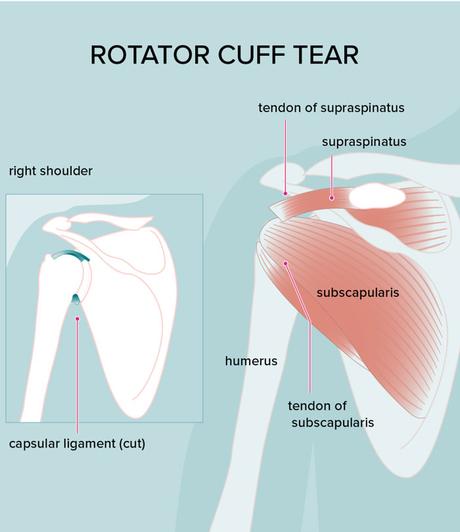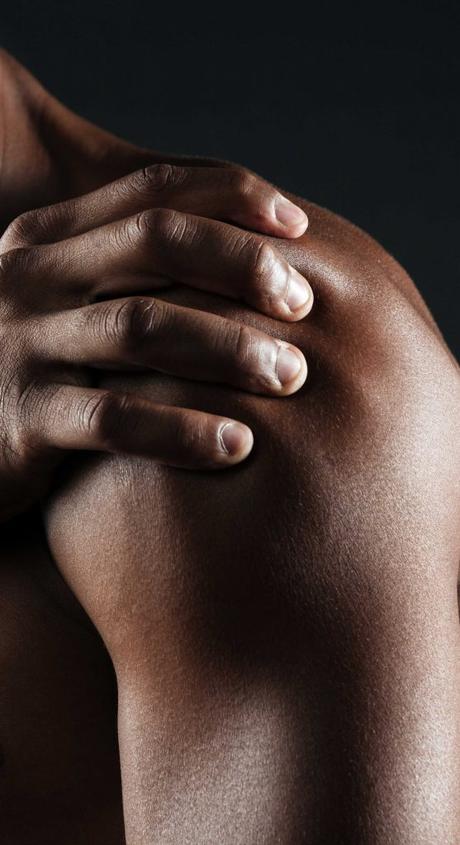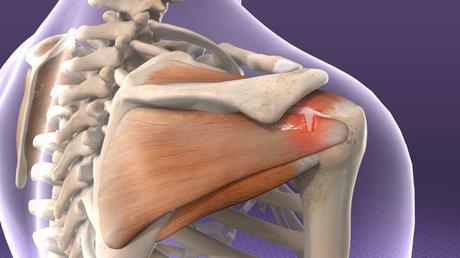Rotator cuff injury or muscle spasm around the shoulder
One of the best ways to treat shoulder injuries is shoulder physiotherapy; shoulder rotator cuff injuries range in severity from simple inflammation to complete rupture.
A rotator cuff is a group of muscles and tendons that surround the shoulder joint and hold the head of the upper half of the arm firmly in the shallow shoulder socket.
Damage to the rotator cuff muscles can lead to chronic pain in the shoulder, which often worsens when the person tries to sleep on the affected side.
Shoulder extensor muscle damage often occurs in people who frequently perform overhead movements in their job or sport.
Like painters, carpenters, and people who play baseball or tennis.

The Risk of Shoulder Muscle Injury Increases with Age
Many people get rid of rotator cuff disease with shoulder physical therapy exercises that strengthen the flexibility and strength of the muscles surrounding the shoulder joint.
Sometimes rotator cuff tears occur as a result of a single injury. In this situation, medical care should be taken immediately.
Severe rotator cuff tears require surgery, tendon replacement, or joint replacement.
Shoulder extensor muscles include a group of muscles and tendons that hold the shoulder joint in place and allow the arm and shoulder to move.
Problems occur when part of the rotator cuff muscles become irritated or damaged.
This can lead to pain, weakness, and reduced range of motion.
Symptoms of Shoulder Muscle Damage, especially The Rotator Cuff
Pain associated with shoulder head muscle damage may:
- Described as chronic pain in the depth of the shoulder
- Disrupt sleep, primarily if the person lies on the affected shoulder
- Make it difficult to comb the hair or reach the back
- accompanied by hand weakness
Time to see a doctor
A family doctor can treat short-term shoulder pain. If a person experiences weakness in his hand immediately after the injury, he should see a doctor immediately.

Causes of Shoulder Muscle Damage
Rotator cuff disease can result from significant damage to the shoulder or wear and tear of the tendon tissue. Repeated overhead activity or lifting heavy objects can irritate or damage the tendon.
Risk factors
The following factors can increase the risk of shoulder rotator cuff injury:
- Age
With age, the risk of rotator cuff injury increases. Rotator cuff tears are most common in people over the age of 40.
- Special sports
Athletes who regularly use repetitive hand motions, such as baseball pitchers, archers, and tennis players, are at higher risk for shoulder rotator cuff injuries.
- Construction professions
Jobs such as carpentry or building painting require repetitive hand movements, often overhead, which can damage the rotator cuff over time.
- Family history
A genetic component may also play a role in shoulder rotator cuff injuries, as these injuries are more common in certain families.
Sacroiliac Joint Dysfunction Carpal Tunnel SyndromeComplications of Rotator Cuff Injury
Without treatment, rotator cuff problems may lead to permanent loss of mobility or weakness and can cause shoulder joint degeneration. Although resting the shoulder is essential for recovery, immobilizing the shoulder for long periods can cause the connective tissue surrounding the joint to thicken and stiffen (frozen shoulder).
Prevention of Rotator Cuff Muscle Damage
Exercises that include hand presses against the wall can help strengthen the muscles that make up the rotator cuff muscles.
With your elbows at a 90-degree angle, place your palms on the wall or door frame in front of you (A).
Place a folded towel between your side and arm.
The goal is to hold the towel there for a few seconds while pressing your palms against the wall or frame.
In the second exercise, hold the towel in place and move your body to stand next to the wall (B).
With your elbows at a 90-degree angle, press your elbows and shins against the wall for a few seconds.
Repeat each exercise 10 times in five rounds.
If a person is prone to shoulder rotator cuff injury or has had a shoulder injury, daily shoulder stretches, and strengthening exercises can help prevent future injuries.
Most people strengthen the front muscles of the chest, shoulders, and arms, but it is equally important to enhance the forces behind the shoulder and around the shoulder blade, to achieve optimal shoulder muscle balance. (A doctor or physical therapist can help a person develop an exercise program.)

Diagnosing Shoulder Extensor Muscle Injuries
During the physical examination, the doctor will apply pressure on different shoulder points and move the person’s hand in different positions. He will also test the strength of the muscles around the shoulders and arms.
In some cases, he may also order imaging tests, including:
- X-Ray
Although a rotator cuff tear is not shown on an X-ray test, this test can reveal bone spurs or other potential causes of pain – such as arthritis.
- Ultrasound
An ultrasound test uses sound to produce images of the body’s internal structures, exceedingly soft tissues such as muscles and tendons.
This test provides the conditions for conducting a dynamic test to evaluate the structure of the shoulder during movement.
This test also allows a quick comparison between the involved and healthy shoulder.
- Magnetic resonance imaging (MRI)
This technology uses radio waves and a strong magnet. The obtained images show all the structures of the shoulder in full detail. The quality of the images largely depends on the quality of the equipment used.
Treatment of Rotator Cuff Injuries
Sometimes traditional treatments—such as rest, ice, and physical therapy—are all needed to heal a shoulder rotator cuff injury. Surgery may be required if severe damage involves a complete muscle or tendon tear.
- Injection
If traditional treatments do not reduce the pain, the doctor prescribes a steroid injection into the shoulder joint, significantly if the pain interferes with sleep, daily activities, and exercises.
While most such injections work temporarily, they must be used carefully because they can contribute to the weakening of the tendon.
- Physiotherapy of shoulder muscles
Physiotherapy is usually one of the first treatments that the doctor suggests. Exercises specific to the rotator cuff muscles’ damaged area can help restore shoulder flexibility and strength. Physical therapy is also essential to the recovery process after rotator cuff surgery.
- Surgery
There are different types of surgeries for muscle injuries, including:
- Tendon repair by the arthroscopic method
- Open tendon repair
- Tendon transfer
- Shoulder replacement

